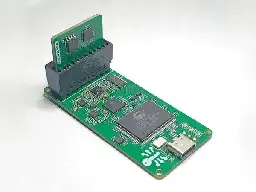Embedded
- Embedded Linux without Yocto
Hello all, I'm an embedded software guy struggling with Yocto. I'm not asking for assistance as I cannot be saved. Rather, I'd like to make my own. How hard it would be to put a Linux distro onto a device without it? For example, if I were to get a perfectly good distro (let's just say Debian) with the right architecture going in a container. Is there a simple way to combine that with u-Boot, and other crap from a SoC manufacturer to build an image? If that is oversimplifying, I've done Linux from scratch before, and I'd be willing to go that route as well. I guess the issue boils down to the specifics like building the image and anything else that I'm not aware of.
So, what part of this idea is going to be a lot harder than I'm giving it credit for?
By the way, I'm aware of Buildroot. This is more for learning purposes, and who knows... maybe I will actually make something out of it.
- Thoughts on CLion from JetBrains for STM32 development?
Context :
I hate when I need to use multiple tools to achieve what I need.
In my current project, I have a few python scripts to simulate what a PC connected to a NUCLEO-F439ZI would send normally (I am not in charge of the PC software, but still need to do hardware testing).
I stumbled upon CLion which has both support for Python and Embedded C through OpenOCD out of the box. I like the modernity of the IDE compared to STM32CubeIDE, especially the auto-complete feature and code snippet, which is really janky on CubeIDE.
However, there is a license cost associated with CLion. Right now I am alone working on my projects, but eventually, the team would grow and would need additional licenses. And it's proprietary source, which isn't my preferred model.
Have you had experience with both? Or one or the other is fine as well.
I am just looking for experiences of different kind of users than me.
Thanks.
- Kévin Courdesses Breaks the ESP32-V3, ESP32-C3, and ESP32-C6 Wide Open with a Side-Channel Attackwww.hackster.io Kévin Courdesses Breaks the ESP32-V3, ESP32-C3, and ESP32-C6 Wide Open with a Side-Channel Attack
"There is no software [or] hardware fix available," Espressif warns of vulnerabilities allowing for encrypted flash data exfiltration.

Hardware and embedded software engineer Kévin Courdesses has replicated research into breaking the flash encryption on selected Espressif ESP32 microcontrollers — including the ESP32-C3 and ESP32-C6 — using side-channel attacks to extract data and even bypass secure boot functionality.
"I recently read the Unlimited Results: Breaking Firmware Encryption of ESP32-V3 (Abdellatif et al, 2023) paper," Courdesses explains. "This paper is about breaking the firmware encryption feature of the ESP32 SoC [System on Chip] using a side-channel attack. This was an interesting read, and soon, I wanted to try to reproduce these results. To understand everything about this attack, I wanted to start from scratch, even if it meant sometimes reinventing the wheel."
- New RISC-V emulator for Computer Science education | GitHub - gboncoffee/egg: Emulador Genérico do Gabrielgithub.com GitHub - gboncoffee/egg: Emulador Genérico do Gabriel
Emulador Genérico do Gabriel. Contribute to gboncoffee/egg development by creating an account on GitHub.

More Discussion on Hacker News:
New RISC-V emulator for Computer Science education (github.com/gboncoffee)
Just released EGG, an emulator created for teaching Assembly and microprocessors (designed to suit the needs of the Microprocessors classes, at Universidade Federal do Paraná, Brazil). The emulator will support multiple architetures in the future, but currently only RISC-V is implemented.
The
eggpackage itself provides only an interface for interacting with machines, thus supporting different architeture backends. Currently, the only backend implemented is egg/riscv, which implements a RISC-V IM 32 bits machine. A MIPS backend is coming soon.egg/assembleralso provides a small library for creating assemblers, and the support for EGG's debugger. - New RISC-V processors address demand for open source and performancewww.embedded.com RISC-V processors meet demand for open source & performance
RISC-V Summit sees new processors from Synopsys and Ventana, shows traction among firms like Qualcomm, and new OpenHW Group platform.
- Azure RTOS goes open-source as Eclipse ThreadXwww.embedded.com Azure RTOS goes open-source as Eclipse ThreadX - Embedded.com
A vendor-neutral open source RTOS certified for safety-critical applications is an “industry game changer”.
- AMD’s Versal VP1902 Premium Adaptive SoC becomes “World’s Largest FPGA”www.eejournal.com With 18.5 million logic cells, AMD’s Versal VP1902 Premium Adaptive SoC becomes “World’s Largest FPGA”
In the relatively narrow world of FPGA-based prototyping and emulation, bigger FPGAs are always better. Always. With its 18.5 million logic cells, AMD’s Versal VP1902 Premium Adaptive SoC has just …
